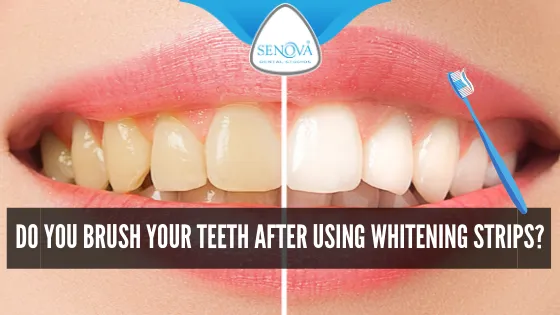What are Teeth Whitening Strips?
Teeth whitening strips are a popular and convenient method for achieving a brighter, more confident smile. These thin, flexible strips are coated with a peroxide-based whitening agent, typically hydrogen peroxide or carbamide peroxide. They are designed to adhere directly to the surface of your teeth, delivering the whitening ingredients where they are needed most. These strips are widely available over-the-counter, making them an accessible option for those seeking to enhance their smile without a professional dental visit. The appeal of whitening strips lies in their ease of use and relatively low cost compared to other professional whitening treatments. They offer a simple way to gradually lighten the shade of your teeth by removing surface stains and, in some cases, penetrating deeper into the enamel to address discoloration.
How Do Teeth Whitening Strips Work?
The active ingredient in most teeth whitening strips, hydrogen peroxide or carbamide peroxide, works by breaking down the stains on your teeth through an oxidation process. When the strip comes into contact with your teeth, the peroxide penetrates the enamel and dentin, where it interacts with the stain molecules. This chemical reaction breaks down the stain molecules into smaller, less visible particles, thereby lightening the overall shade of your teeth. The concentration of peroxide varies among different brands and types of strips, which affects the whitening effectiveness and the time required to see results. The longer the strip is in contact with the teeth and the higher the peroxide concentration, the more intense the whitening effect, but also the greater the potential for sensitivity. It is important to follow the manufacturer’s instructions carefully to achieve the desired results safely.
Step-by-Step Guide to Using Whitening Strips

Using teeth whitening strips is a straightforward process, but following the instructions correctly is crucial for achieving optimal results. Begin by thoroughly reading the instructions provided with your specific brand of whitening strips. Start by gently brushing your teeth to remove any surface debris, but avoid using toothpaste, as it can create a barrier. Peel the strips from their backing and apply them to your upper and lower teeth, aligning the strip with your gumline. Press gently to ensure the strips adhere properly to the surface of your teeth. The next step involves leaving the strips on for the duration specified by the manufacturer, usually 30 minutes to an hour. After the allotted time, remove the strips and discard them. Rinse your mouth with water to remove any remaining gel, and admire your brighter smile. Remember to be consistent with the application as recommended by the manufacturer to see noticeable results.
Preparing Your Teeth Before Whitening
Preparing your teeth before using whitening strips can enhance the effectiveness of the treatment and minimize potential side effects. Before applying the strips, brush your teeth gently to remove any food particles or plaque. Avoid using toothpaste, as it can create a barrier and reduce the efficacy of the whitening agent. Floss your teeth to ensure the removal of debris from between your teeth, maximizing contact between the whitening strips and your teeth’s surface. If you have any dental work, such as fillings or crowns, be aware that whitening strips will not lighten these. Consider consulting with your dentist before starting any whitening treatment, especially if you have sensitive teeth, as they can provide personalized advice. It is also important to wait a few weeks after a dental cleaning before starting to whiten, so your teeth are more receptive to the treatment.
Applying the Whitening Strips
Applying the whitening strips is a crucial step in the process. Once your teeth are prepared, carefully peel the strips from their backing. Typically, you’ll receive separate strips for your upper and lower teeth. Apply the longer strip to your upper teeth, aligning it with your gumline. Press gently to ensure the strip adheres fully to the surface of your teeth. Repeat this process with the shorter strip on your lower teeth. Make sure to avoid touching your gums as the whitening agent can cause irritation. Ensure good contact between the strips and your teeth by smoothing out any air bubbles. The duration for leaving the strips on varies based on the product, usually 30 minutes to an hour, so follow the specific instructions. After the specified time, gently remove the strips and discard them.
Post-Whitening Care for Maximum Results

Proper post-whitening care is essential for achieving and maintaining a brighter smile. After removing the whitening strips, rinse your mouth with water to remove any residual gel. Avoid eating or drinking anything, particularly staining foods and beverages like coffee, tea, red wine, and berries, for at least an hour after treatment. If you experience any tooth sensitivity, use a toothpaste designed for sensitive teeth. Maintain a consistent oral hygiene routine, including brushing twice daily and flossing regularly, to remove plaque and prevent new stains. Consider using a whitening toothpaste or mouthwash to help extend the whitening effect. It is also crucial to schedule regular dental check-ups and cleanings to monitor your oral health and address any potential issues promptly. Avoiding smoking and tobacco products also helps preserve the results of your whitening treatment.
Should You Brush Your Teeth After Whitening Strips?
The question of whether you should brush your teeth immediately after using whitening strips is often a point of confusion. Generally, it is recommended to avoid brushing your teeth immediately after using whitening strips. The whitening agent temporarily softens the enamel, and brushing immediately afterward could potentially cause abrasion and increase sensitivity. Instead, rinse your mouth thoroughly with water to remove any residual whitening gel. Wait at least 30 minutes to an hour before brushing your teeth, allowing time for your enamel to re-harden. When brushing, use a soft-bristled toothbrush and apply gentle pressure to avoid irritating your gums. Consider using a toothpaste formulated for sensitive teeth to further reduce any potential discomfort.
Factors Affecting Whitening Results
Several factors can influence the effectiveness of teeth whitening strips. The type and severity of the stains on your teeth play a significant role; surface stains typically respond better than deep-seated discoloration. The concentration of the whitening agent and the duration of application affect the results. The more potent the agent and the longer the contact time, the more noticeable the whitening effect, but the greater the potential for sensitivity. Your oral health, including the presence of cavities or gum disease, can also impact your results, so it’s important to address these issues before starting. Individual tooth enamel properties, such as its porosity and thickness, also play a role. Certain lifestyle choices, such as smoking and consuming staining foods and beverages, can counteract the whitening effect, requiring you to adapt your diet to maintain results. Genetics can also influence the natural shade of your teeth and how well they respond to whitening treatments.
Maintaining Your Bright Smile

Maintaining your bright smile requires a consistent approach to oral hygiene and lifestyle choices. Continue to brush your teeth twice daily with a fluoride toothpaste, focusing on proper technique to remove plaque and prevent new stains. Floss daily to remove food particles and plaque from between your teeth, areas that are difficult to reach with a toothbrush. Schedule regular dental check-ups and professional cleanings to remove any persistent stains and address any emerging dental problems. Minimize your consumption of staining foods and drinks, such as coffee, tea, red wine, and berries. If you do consume these items, rinse your mouth with water immediately afterward to reduce staining. Avoid smoking and tobacco products, as they are major contributors to teeth discoloration. Consider using a whitening toothpaste or mouthwash to help maintain the brightness of your teeth between treatments. With consistent care, you can enjoy your brighter smile for a long time.
